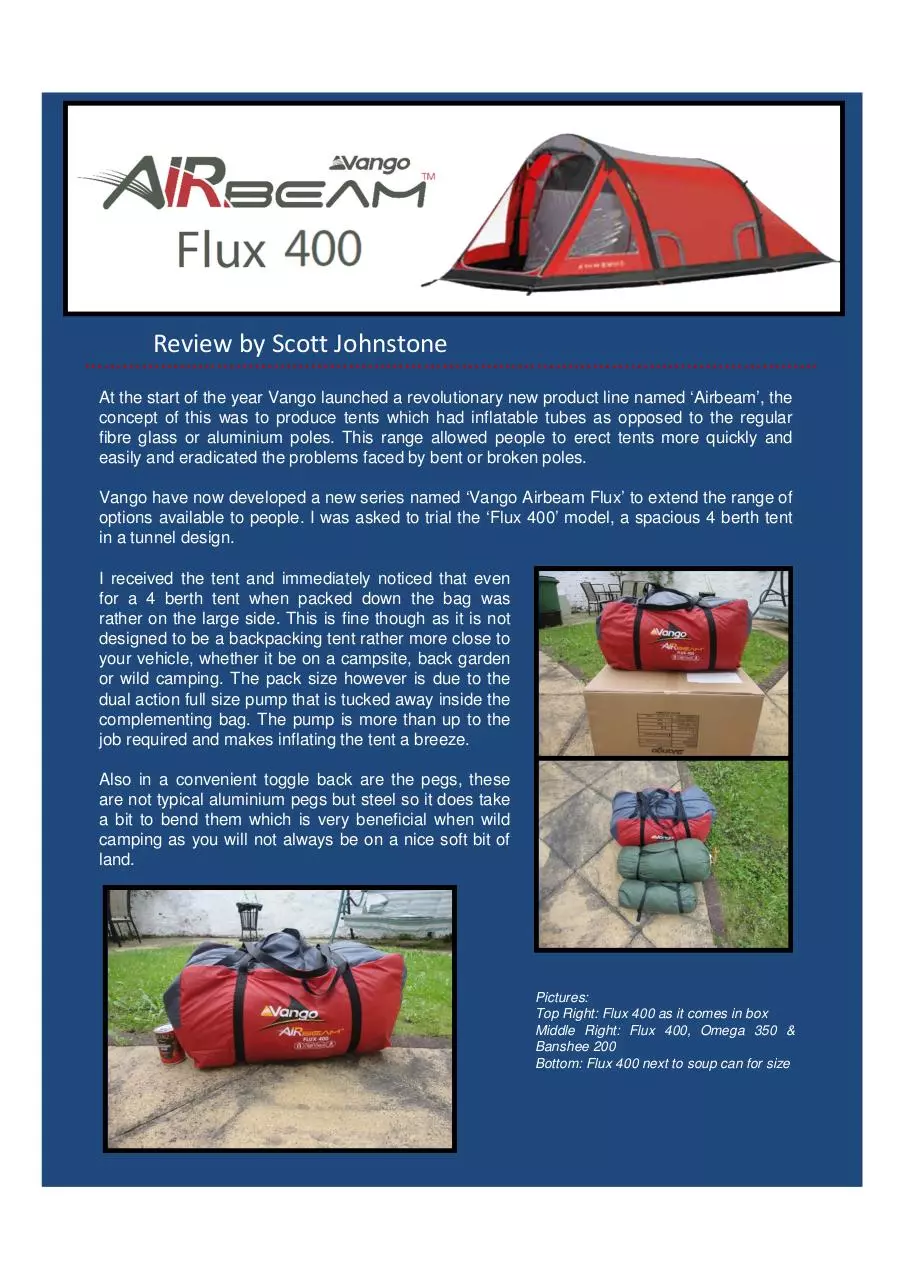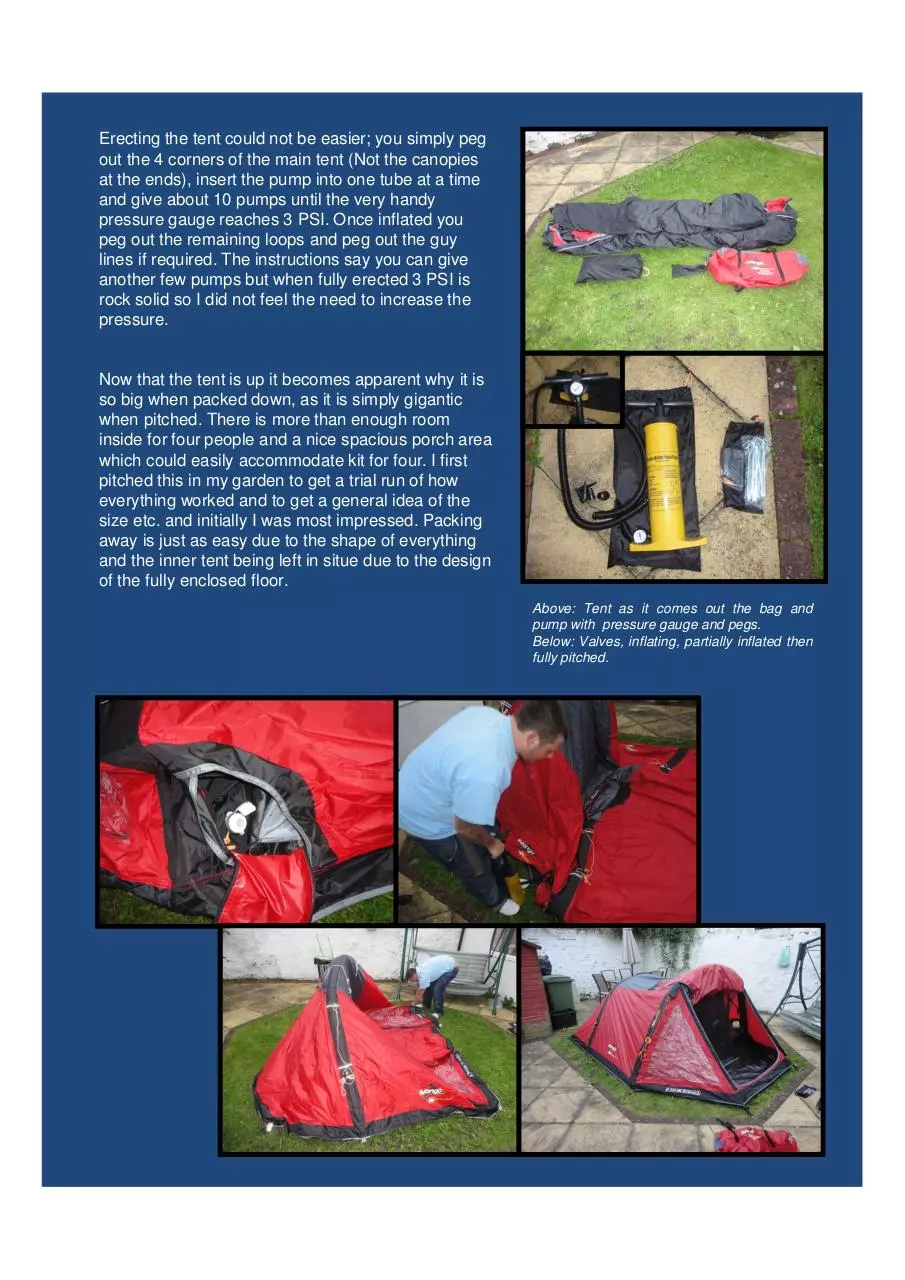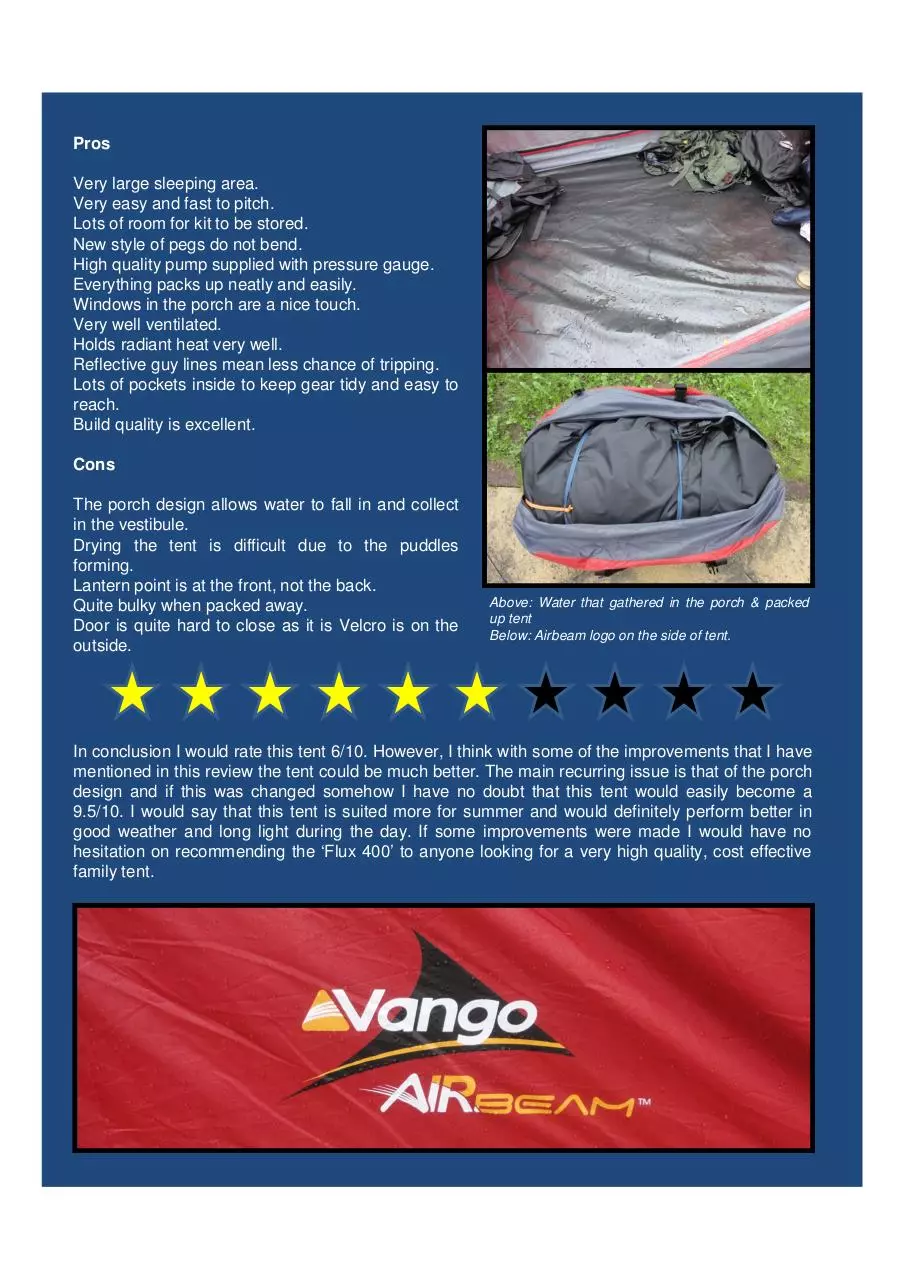Flux 400 Review (PDF)
File information
Title: Microsoft PowerPoint - Flux 400 Review.pptx
Author: Jinsin
This PDF 1.4 document has been generated by PScript5.dll Version 5.2.2 / GPL Ghostscript 8.15, and has been sent on pdf-archive.com on 17/11/2011 at 22:04, from IP address 92.13.x.x.
The current document download page has been viewed 1419 times.
File size: 3.84 MB (4 pages).
Privacy: public file




File preview
Review by Scott Johnstone
………………………………………………………………………………………………………
At the start of the year Vango launched a revolutionary new product line named ‘Airbeam’, the
concept of this was to produce tents which had inflatable tubes as opposed to the regular
fibre glass or aluminium poles. This range allowed people to erect tents more quickly and
easily and eradicated the problems faced by bent or broken poles.
Vango have now developed a new series named ‘Vango Airbeam Flux’ to extend the range of
options available to people. I was asked to trial the ‘Flux 400’ model, a spacious 4 berth tent
in a tunnel design.
I received the tent and immediately noticed that even
for a 4 berth tent when packed down the bag was
rather on the large side. This is fine though as it is not
designed to be a backpacking tent rather more close to
your vehicle, whether it be on a campsite, back garden
or wild camping. The pack size however is due to the
dual action full size pump that is tucked away inside the
complementing bag. The pump is more than up to the
job required and makes inflating the tent a breeze.
Also in a convenient toggle back are the pegs, these
are not typical aluminium pegs but steel so it does take
a bit to bend them which is very beneficial when wild
camping as you will not always be on a nice soft bit of
land.
Pictures:
Top Right: Flux 400 as it comes in box
Middle Right: Flux 400, Omega 350 &
Banshee 200
Bottom: Flux 400 next to soup can for size
Erecting the tent could not be easier; you simply peg
out the 4 corners of the main tent (Not the canopies
at the ends), insert the pump into one tube at a time
and give about 10 pumps until the very handy
pressure gauge reaches 3 PSI. Once inflated you
peg out the remaining loops and peg out the guy
lines if required. The instructions say you can give
another few pumps but when fully erected 3 PSI is
rock solid so I did not feel the need to increase the
pressure.
Now that the tent is up it becomes apparent why it is
so big when packed down, as it is simply gigantic
when pitched. There is more than enough room
inside for four people and a nice spacious porch area
which could easily accommodate kit for four. I first
pitched this in my garden to get a trial run of how
everything worked and to get a general idea of the
size etc. and initially I was most impressed. Packing
away is just as easy due to the shape of everything
and the inner tent being left in situe due to the design
of the fully enclosed floor.
Above: Tent as it comes out the bag and
pump with pressure gauge and pegs.
Below: Valves, inflating, partially inflated then
fully pitched.
The real test for the tent was when I took it camping for
two days to Glentrool, on the West coast of Scotland
as
part
of
an
event
organised
through
BushcraftUK.com. This gave me the chance to give it a
thorough testing and gather the views of other like
minded individuals.
This is where I discovered the major drawback of this
tent and ultimately this design of tent. Due to the
design of the door when it is raining the water will sit on
the door and when opened will run into the floor of the
porch. I tried several ways of opening the door to try
and stop this but nothing worked and it just seemed to
be down to the design. The full bathtub floor makes
this even more of an inconvenience as the water
gathers on the vestibule and forms puddles which
cannot be drained without taking the tent down. This is
a major problem as it means that you cannot enter the
tent without getting wet and all the kit stored in the
porch will get wet. This, in my eyes, renders the porch
useless for gear storage and effectively renders the
tent a 2 berth with room for two lots of kit. Also, due to
the enclosed floor this also means that cooking in the
porch is probably not recommended as it could scorch
the floor. The fully enclosed floor would however be
good in good dry weather as this would make it more fit
for storing kit and also give a place to sit when cooking,
whittling etc.
Above: Tent pitched at BCUK event at Glentroool
There is a bug screen that can be zipped closed to act as a door that will keep bugs at bay but will still
allow the air to circulate and the user to be able to see out of. I think the vestibule should be made
removable but in a quick and easy way in the same spirit as the quick and easy nature of the tent
itself. I would personally either secure it with some sort of zip or perhaps include a drain plug in the
bottom that can be sealed, that allows the user to drain the puddles without having to take down the
tent. The puddles might also come from the fact that the door is hard to close, there are two zips that
run vertically down either side of the door but the bottom has Velcro along the outside, this makes it
quite tricky to close and seal from the inside.
Apart from this one drawback, the tent performed flawlessly over the entire weekend, the 3000mm
Hydrostatic Head meant that no rain could penetrate into the inner tent so I was warm and dry all
weekend. Again, the tent was very roomy inside and retained the radiant heat very well. while still
staying very ventilated and condensation free. There is an option to have some of the inner tent door
open with mesh and this allows ventilation. Even during particularly strong winds the tent stood
strong, another advantage of using air filled tubes; they will deflect but will simply spring back into
shape as opposed to bending or breaking. Everyone at the event seemed impressed by the pitch time
and size but it is hard to give it full marks when there are puddles in the porch floor.
Another little feature that I feel could be changed is the location of the lantern hanging point; it is at
the front, next to the door, this is rather annoying as I use a candle lantern whilst in a tent but could
not light it for fear of burning the door. With every other Vango tent I own the hanging point is at the
back and means the lantern is free from touching anything plus you don’t have to try and avoid it
when entering the tent.
Pros
Very large sleeping area.
Very easy and fast to pitch.
Lots of room for kit to be stored.
New style of pegs do not bend.
High quality pump supplied with pressure gauge.
Everything packs up neatly and easily.
Windows in the porch are a nice touch.
Very well ventilated.
Holds radiant heat very well.
Reflective guy lines mean less chance of tripping.
Lots of pockets inside to keep gear tidy and easy to
reach.
Build quality is excellent.
Cons
The porch design allows water to fall in and collect
in the vestibule.
Drying the tent is difficult due to the puddles
forming.
Lantern point is at the front, not the back.
Quite bulky when packed away.
Door is quite hard to close as it is Velcro is on the
outside.
Above: Water that gathered in the porch & packed
up tent
Below: Airbeam logo on the side of tent.
In conclusion I would rate this tent 6/10. However, I think with some of the improvements that I have
mentioned in this review the tent could be much better. The main recurring issue is that of the porch
design and if this was changed somehow I have no doubt that this tent would easily become a
9.5/10. I would say that this tent is suited more for summer and would definitely perform better in
good weather and long light during the day. If some improvements were made I would have no
hesitation on recommending the ‘Flux 400’ to anyone looking for a very high quality, cost effective
family tent.
Download Flux 400 Review
Flux 400 Review.pdf (PDF, 3.84 MB)
Download PDF
Share this file on social networks
Link to this page
Permanent link
Use the permanent link to the download page to share your document on Facebook, Twitter, LinkedIn, or directly with a contact by e-Mail, Messenger, Whatsapp, Line..
Short link
Use the short link to share your document on Twitter or by text message (SMS)
HTML Code
Copy the following HTML code to share your document on a Website or Blog
QR Code to this page

This file has been shared publicly by a user of PDF Archive.
Document ID: 0000035243.